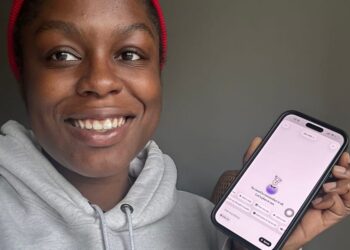On a recent evening in Fulton, N.Y., an industrial town that straddles the Oswego River, Maribel Lopez’s three children huddled around a cellphone glowing on the kitchen table. She smiled at them from thousands of miles away, wiping away tears.
“Chito, Chito, you cutie,” Ms. Lopez called softly to her youngest, Jorge, 2, who was propped on the lap of his brother, Milton, 23.
The toddler didn’t respond to his nickname, and gave the screen displaying his mother’s image only a fleeting glance.
“Say ‘hola, mami,’” pleaded his sister, Anallely, 21.
Ms. Lopez has been separated from her children since early September, when federal agents raided the nutrition-bar factory where she worked in Central New York. Ms. Lopez was detained and deported to Guatemala, leaving behind her 2-year-old son.
It shouldn’t have happened.
Ms. Lopez was supposed to be protected from deportation because she had a pending asylum case on appeal, after fleeing years of abuse in her home country.
With immigration agents under intense pressure to deport thousands of people each day, Ms. Lopez was pushed through the system swiftly and was deported within four days of the factory raid.
As a result, Jorge is now cared for by two siblings who are barely adults themselves.
The government returned Ms. Lopez to the United States late on Thursday because of the mistake. But she is still apart from him, held in a detention center while her asylum appeal works its way through the courts.
The case is one of a growing number of family separations that, to some, recall the policies of the first Trump administration, when children were pried from their parents’ arms soon after they crossed the southern border into the United States.
These cases, though, target immigrants who are already living in the United States.
Immigration officials say parents who are being deported are given the option of bringing their U.S. born children with them as they are removed from the country.
But Ms. Lopez said she was offered no such choice.
Rather, her deportation was an error, email communications between her lawyers and Immigration and Customs Enforcement indicate, and the speed at which it took place appears to have separated her from her son.
Tricia McLaughlin, a spokeswoman for the Homeland Security Department, said that ICE, which carries out deportations, “does not separate families.”
“Parents are asked if they want to be removed with their children, or ICE will place the children with a safe person the parent designates,” she said. “This is consistent with past administrations’ immigration enforcement.”
But immigration lawyers and advocacy groups say the speed and scale at which federal agents are effecting deportations is leading to family separations.
“We are seeing a disturbing rise in cases where mothers and families are deported without their children,” said Kelly Kribs, an immigration lawyer at the Young Center for Immigrant Children’s Rights.
It is unclear exactly how many parents have been deported without their children, or how many were given a choice to be deported together. Advocates say there is no national data, and the Homeland Security Department did not respond to a request for figures.
Deportations involving a parent of a U.S.-born child are challenging, often forcing families to make a wrenching decision to stay together or leave their children behind, either with a family guardian or in the foster care system.
“The government’s actions are creating an atmosphere where families feel they have to choose between their due process rights to protections under immigration law and the security of staying together despite not knowing if they will be safe wherever they are returned to, “ said Nan Schivone, legal director of Justice in Motion, a nonprofit that has been serving families deported to Central America.
In the raid that scooped up Ms. Lopez at Nutrition Bar Confectioners in Cato, N.Y., 57 people were detained, and 17 of them were parents, who collectively had more than 20 children, according to the Workers’ Center of Central New York, a nonprofit that advocates for low-wage workers. At least seven of the parents have already been deported, and more are expected to be expelled.
An Inadvertent Deportation
In communications reviewed by The New York Times, ICE acknowledged that Ms. Lopez was “inadvertently” removed from the United States. Ms. Lopez had the right to remain in the country because she had an active asylum appeal.
Her lawyer, Elizabeth Brundige, a professor at Cornell Law School, said the removal of Ms. Lopez to Guatemala was “a clear violation of U.S. and international law.”
Ms. McLaughlin, the DHS spokeswoman, contended that Ms. Lopez had “received due process” and added that “Ms. Lopez had a removal order issued by an immigration judge in 2019.”
However, that order was stayed when Ms. Lopez filed an appeal. That is why ICE attorneys characterized Ms. Lopez’s deportation as erroneous.
Officers under pressure to boost deportation numbers are processing detainees hastily and putting them on planes without always asking parents whether they wish to take their children with them, according to lawyers who handle immigration cases.
“There is complete disregard for the sanctity of family,” said Ruby Powers, an immigration lawyer in Houston.
ICE is not required to reunite families before deporting a parent. An agency directive dated July 2 instructs officers to help the parent arrange care for minor children, but only “to the extent operationally feasible.”
The Department of Homeland Security did not respond to questions seeking clarification about how and when that would be done.
During Mr. Trump’s first term, his “zero-tolerance” policy took thousands of migrant children away from their parents at the border. After drawing national outrage, the policy was rescinded.
Now, when parents are separated from their children by immigration authorities, it is happening quickly and quietly.
“These new separations are a response to the enormous pressure to deliver unrealistic deportation numbers — far from the public eye,” said Mary Giovagnoli, an immigration lawyer and policy expert.
A Raid in Rural New York
Ms. Lopez was halfway through her 4 a.m.-to-12:30 p.m. shift at the nutrition-bar plant on Sept. 4 when a command crackled over the building’s public address system: “All workers report to the lunchroom.”
Ms. Lopez, 41, complied, still wearing her white lab coat, hairnet and face mask.
Inside her purse, she said, were her work permit, Social Security card and a letter from her lawyer on Cornell Law School stationery stating that Ms. Lopez had a pending asylum appeal and was “lawfully in the United States and cannot be removed.”
Moments later, armed agents began separating the workers into two groups — U.S. citizens and immigrants. Ms. Lopez showed an agent her valid work permit, and was initially placed with the citizens. But another agent ordered her to join the other group.
She called her children and her lawyer, Ms. Brundige, who recalled telling her, “Make sure and give them all your documents, and see if they will talk to me.”
Instead, an agent seized her phone and switched it to airplane mode, Ms. Lopez said. Her wrists were bound, she said, and she was loaded into a van with other women.
At a Border Patrol station in nearby Oswego, N.Y., officers tapped each worker’s name into a computer. Ms. Lopez saw her entire immigration history pop up, and she handed over her documents, including the Cornell letter.
Ms. Lopez also produced her toddler’s Social Security card.
“He’s two years old,” she said she told the officer. “He needs me.”
By the next morning, Ms. Lopez was in Texas. Two days later, she was on a plane to Guatemala.
Back home, her son, Jorge, cried for her, “Mami, Mami,” said his sister.
A Fresh Start After Years of Abuse
Ms. Lopez was referred to Cornell’s legal clinic in 2018, shortly after she arrived in New York with her two older children.
“From the start, we could tell she had a very strong case for asylum, based on the horrendous abuse she experienced, which constituted persecution,” Ms. Brundige said. And under the Convention Against Torture, people cannot legally be returned to a country where they face the risk of torture, she said.
Medical and police reports, as well as testimonials from family members that are attached to Ms. Lopez’s 44-page asylum court filing detail how she endured brutal, unrelenting abuse for years from her partner, the father of her two older children. He lashed her with belts, hurled glass at her and threatened to stab her, the documents say; he once hacked through a door with a machete, and then choked and struck her.
She filed police report after police report, to no avail. Restraining orders she was granted were not enforced.
Even her religious faith provoked her partner’s rage, the documents say. Attending mass earned her beatings. So did voting in local elections.
Fearing for their lives, Ms. Lopez fled with her children and surrendered to American authorities at the U.S.-Mexican border in Texas in March 2018. A few weeks later, they were released with a notice to appear in court, and headed to rural New York, where a friend had told Ms. Lopez there was work.
She got a job at a dairy farm near Rome, attended church and enrolled in English classes.
“I lived well with my children,” she said in an interview from Guatemala, while in hiding at the home of a relative. In the United States, she said, “I felt safe. I wasn’t afraid of anything.”
At Cornell, law students and professors began building her case.
In January 2019, the team filed her application for asylum.
At a hearing in November 2019, Ms. Lopez testified before an immigration judge for four hours, recounting years of assault, beatings and other violence.
During cross-examination, a government lawyer pressed Ms. Lopez on the timing and sequence of events and her interactions with law enforcement, questions that were challenging for both the court-appointed interpreter and Ms. Lopez to follow, her lawyer said.
The judge denied her asylum claim on credibility grounds, citing inconsistencies in her account. Her lawyers appealed, and her case remains pending.
By 2021, Ms. Lopez had moved to Fulton, 30 minutes from Syracuse, where she worked on the wrapping line at the nutrition-bar factory.
In early 2023, Ms. Lopez discovered that she had an unplanned pregnancy. The father, who was undocumented, soon moved away and could not help raise the child. Ms. Lopez, with the support of her older children, chose to keep the baby.
Jorge was born on Sept. 3, 2023. “He’s a blessing,” she said.
The day after his second birthday, agents raided her workplace.
An Erroneous Deportation
“Our expectation was that once she was able to explain her situation, immigration authorities would understand and release her,” Ms. Brundige said.
Instead,Ms. Lopez found herself calling her children from a border facility in McAllen, Texas.
Shackled at the wrists, waist and ankles, Ms. Lopez was put on a plane in the early hours of Tuesday, Sept. 7.
“I was crying for my children, praying that God would protect them,” Ms. Lopez said.
The next time she spoke to her children, she was in Guatemala.
Ms. Lopez’s Cornell lawyers fired off emails to ICE lawyers in Buffalo. On Sept. 8, the ICE lawyers responded that they had no record of her removal, according to correspondence reviewed by The Times.
The admission came a week later: A Sept. 15 email said Ms. Lopez had been arrested by Customs and Border Protection on Sept. 3 and “inadvertently removed” four days later.
An ICE field office director said in an email on Sept. 22 that he would start the process to allow Ms. Lopez to return to the United States.
On Wednesday, Ms. Lopez received an unexpected call from an official at the American embassy in Guatemala City, informing her that she would be flown back to the United States the next day.
She will remain detained until her immigration case is decided.
Miriam Jordan reports from a grass roots perspective on immigrants and their impact on the demographics, society and economy of the United States.
The post She Was Deported in Error. Her Child Was Left Behind. appeared first on New York Times.




